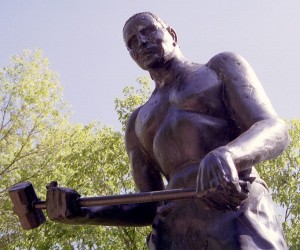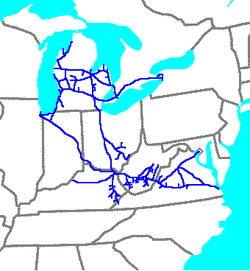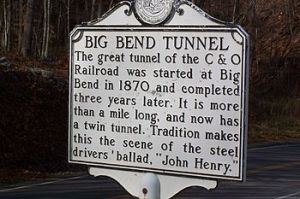Ask any Marvel-eyed moviegoer to describe a hammer and they’d probably say it is powerful, solid, strong, a tool of a god such as Thor…which it is. Well, at least the powerful, solid and strong part.
But a hammer can also be a heavy weight, a burden to carry. And it is this dual personality of the hammer that is evident when looking at the history of the song ‘Take This Hammer’.
In the late 1860’s, when the C&O Railroad began navigating it’s way across the Appalachian Mountains from Chesapeake Bay to the Ohio River, the tunneling and grading was done by men, not machines. Men, mostly former slaves, wielding 9 lb. hammers would create holes in the rock so that explosives could be set, sometimes measuring their progress in centimeters per day. As you can imagine the work was grueling, and it was also extremely dangerous as hundreds lost their lives due to the dust, fumes and unexpected rockslides. So, it is easy to see how the idea of being a man strong enough to rise above this work and somehow leave it behind was the stuff of dreams and legends. The folk hero John Henry was such a man. Based in fact, it is said that he died after having defeated a steam-powered hammer in a contest. Like the hammer itself, in the end it is the dual nature of his story that lives on: the legend of a strong, powerful man conquering the heavy weight of the life he found himself living. Perhaps a hammer is a tool of the gods, after all.
John Henry and his hammer may be the most sung about theme in traditional American music. The variations to be found are numerous: ‘Take This Hammer’, ‘Spike Driver Blues’, ‘John Henry’, ‘Nine Pound Hammer’…the list goes on. Just as varied are the artists who have covered these songs, starting with Mississippi John Hurt’s 1928 version of ‘Spike Driver Blues‘, one of the earliest recordings based on John Henry. Other artists include Merle Travis (Nine Pound Hammer), Bruce Springsteen (John Henry), Mark Knopfler w/Notting Hillbillies (Railroad Worksong), and Leadbelly and Odetta (who both did more than one of these), to name a few. But regardless of the version, it is the lyrics of any of these variations that speak to John Henry’s enduring legacy of strength and hope.
The lyrics of almost any traditional song are fluid in nature. Different verses from different songs coming together in different variations is pretty much the norm. The lyrics the B-Side Growlers choose to use for ‘Take This Hammer’ are:
Chorus: Take this hammer, carry it to the captain (3x), tell him I’m gone, tell him I’m gone.
1. If he asks you, was I running (3x), tell him I was flying, tell him I was flying.
2. If he asks you, was I laughing (3x), tell him I was crying, tell him I was crying.
3. This is the hammer killed John Henry (3x), but it won’t kill me, it won’t kill me.
Along with these lyrics, we intersperse an old fiddle/banjo tune called ‘Logan County Blues’. The Logan County it most likely originates from is found in West Virginia, the heart of early railroad country, including the C&O. We also kept the folk tradition alive by taking a few liberties with the melody and chord progression of ‘Take This Hammer’, staying true to the original but making it our own (check out our video below). We hope we have a chance to share it with you sometime in person. To see if the B-Side Growlers are playing nearby soon, check our Facebook page located here.
Further reading:
Cohen, Norm. Long Steel Rail: The Railroad in American Folksong. Chicago: University of Illinois Press, 2000.
Nelson, Scott Reynolds. Steel Drivin’ Man: John Henry, the Untold Story of an American Legend. New York: Oxford University Press, 2006.




Very informative. This is the perfect addition to the band.
LikeLike
Very nice entry! How fun. I will enjoy reading your posts.
LikeLike